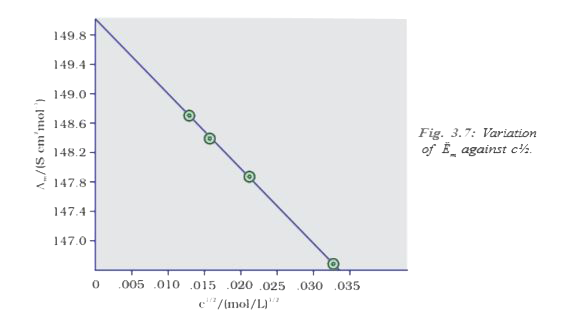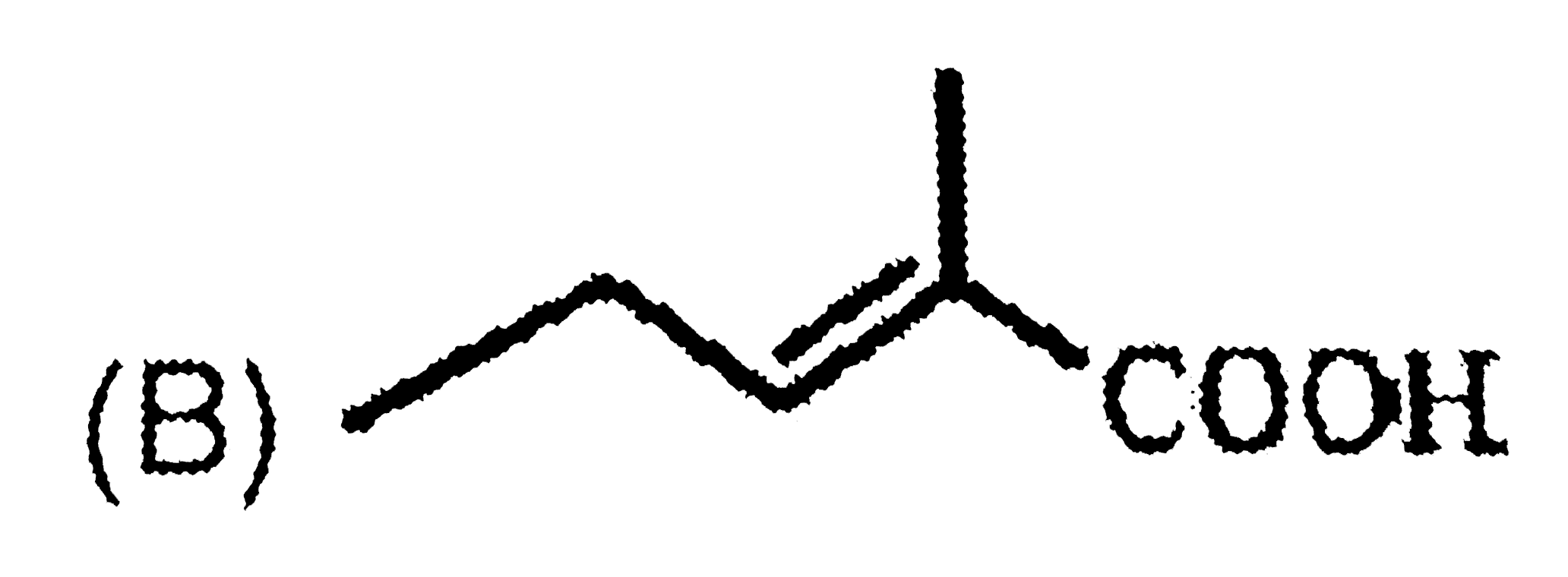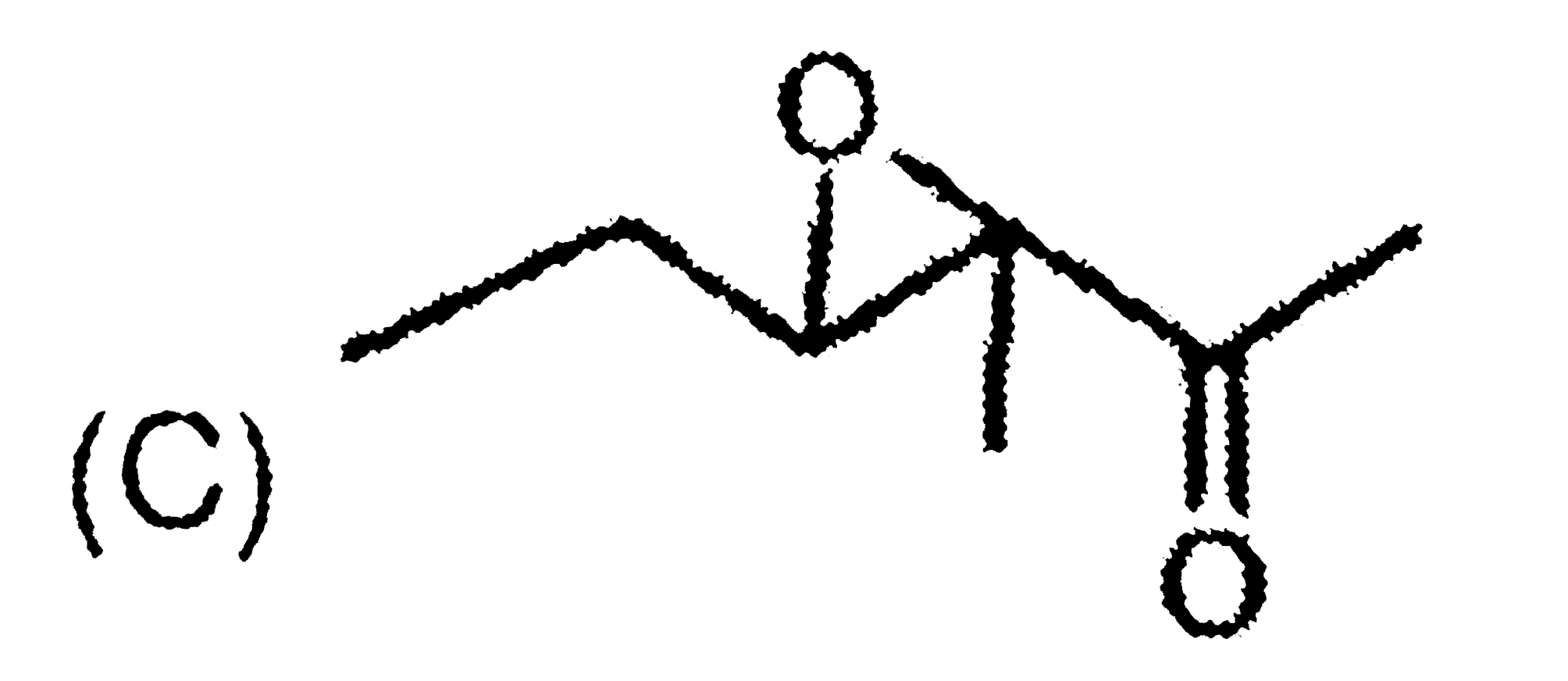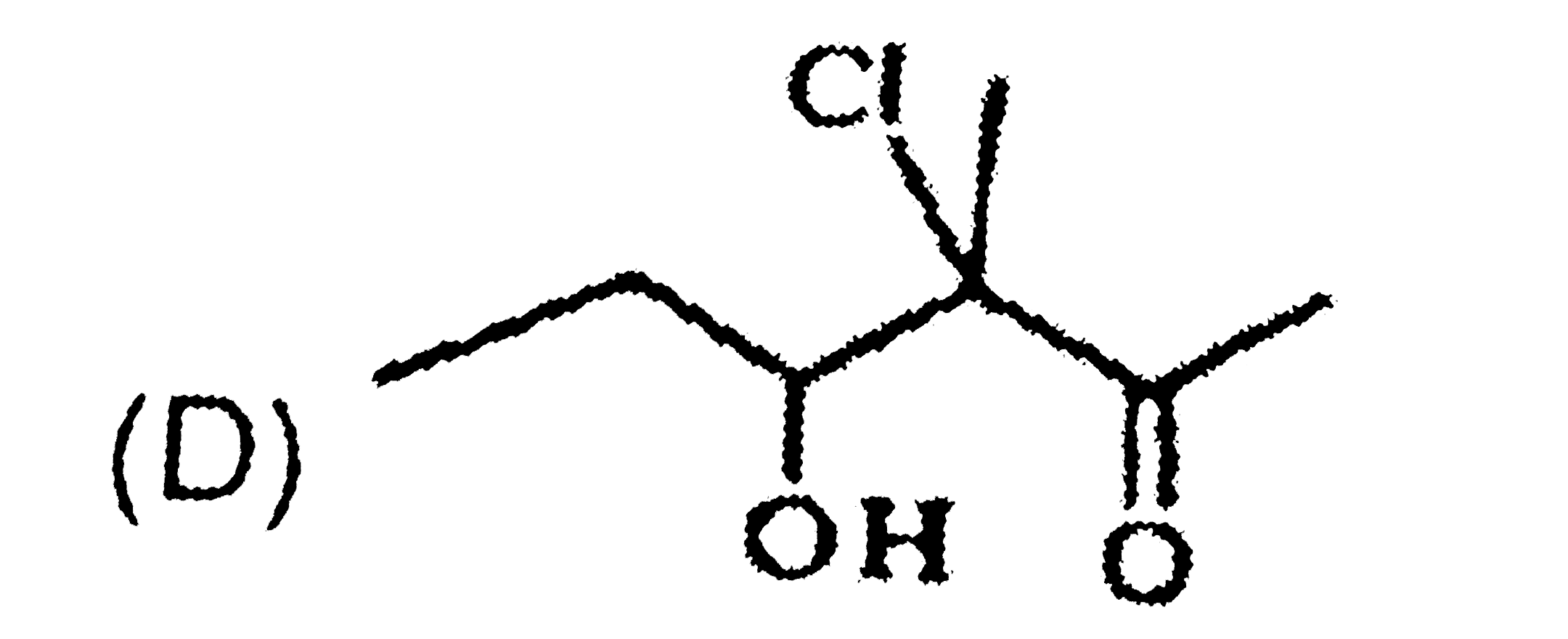Explore topic-wise InterviewSolutions in .
This section includes InterviewSolutions, each offering curated multiple-choice questions to sharpen your knowledge and support exam preparation. Choose a topic below to get started.
| 28701. |
The molal freezing point constant of water is -1.86 K molality^(-1). If 171g of cane sugar (C_12H_22O_11) are dissolved in 500 g of water, the solution will freeze at: |
|
Answer» `-1.86^@C` |
|
| 28702. |
The main source of bromine is |
|
Answer» SILVER BROMIDE ore |
|
| 28703. |
The molar conductivity of the complex CoCl_(3).4NH_(3).2H_(2)O is found to be same as that of 3:1 electrolyte. What is the structural formula. Name and number of geometrical isomer of the complex. |
|
Answer» SOLUTION :As coordination number of Co is 6 and complex should be `A_(3)B`or`AB_(3)` type, formula is`[Co(NH_(3))_(4)(H_(2)O)_(2)]Cl_(3)`. Name: Tetraaminediaqua cobalt(III) chloride GEOMETRICAL isomer: 2(cis and trans) |
|
| 28704. |
The molar conductivity of NH_(4)Cl at infinite dilution is 149.7" S "cm^(2) and the ionic conductivities of OH^(-) and Cl^(-) and are 198 and 96.3 S cm^(2) respectively. Calculate the molar conductivity of NH_(4)OH at this dilution. |
|
Answer» |
|
| 28705. |
The molar elevation constant for water is 0.52^(@). The elevation caused in the boiling point of water by dissolving 0.25 mole of a non-volatile solute in 250 g of water will be |
|
Answer» `0.52^(@)C` `DeltaT_(B)=K_(f)xx m = 0.52xx1=0.52^(@)C` |
|
| 28706. |
The main role of oil and fats as constituents in our foods is to: |
|
Answer» ACT as stored source of energy |
|
| 28707. |
The molar conductivity of the complex CoCl_(3).4NH_(3).2H_(2)O is found to be same as that of 3 : 1 electrolyte. What is the structural formula of the compelx ? |
| Answer» Solution :The complex should be of the type `A_(3)B or AB_(3)`. As coordination NUMBER of Co is 6, hence its structure formula will be `[Co(NH_(3))_(4)(H_(2)O)_(2)]Cl_(3)`. | |
| 28708. |
The molar conductivity of solution of a weak acid HX (0.01 M)is ten times smaller than the molar conductivity of a solution of a weak. acid HY (0.1 M). If lambda_(x^(-))^(@) =lambda_(y^(-))^(@), the difference in their pK_(a) values, {pK_(a)(HX) - pK_(a)(HY)} is ..... . (Consider degree of dissociation of both acids to be lt lt 1. |
|
Answer» As`OVERSET(@)(lambda)_(X^(-)) = overset(@)(lambda)_(y^(-)), overset(@)(Lambda)_(HX) therefore (alpha_(HX))/(alpha_(HY)) = (1)/(10)` `((K_(a))_(HX))/((K_(a))_(HY)) = (0.01 alpha_(HX)^(2))/(0.1 alpha_(HX)^(2))` |
|
| 28709. |
The molar conductivity of KCl solutions at different concentrations at 298K are given below: Show that a plot between Lamda_(m) and c^((1//2)) is a straight line. Determine the values of Lamda_(m)^(@) and A for KCl. |
Answer» Solution :Taking the square root of concentration, we obtain:  Graph of `lamda_(m)=sqrt(c) ` vs `c^(1//2)` is as GIVEN below:  It is nearly a straight line. A=slope=-87.46 S `cm^(2)mol^(-1)("mol "L^(-1))^(1//2)` From the intercept `(c^(1//2)=0)`, we find that `Lamda_(m)^(@)=150.0" S "cm^(2)mol^(-1)`. |
|
| 28710. |
The main role of DNA in a living system is |
|
Answer» It is the structural material of CELL walls |
|
| 28711. |
The molar conductivity of KCl solution at different concentrations at 298K are given below: {:(c//mol" "L^(-1),wedge//S" "cm^(2)mol^(-1),c//mol" "L^(-1),wedge//S" "cm^(2)mol^(-1)),(0.000198,148.61,0.000521,147.81),(0.000309,148.29,0.000989,147.09):} Show that the plot between wedge and c^(1//2) is a straight line. determine the values of wedge^(@) and A for KCl. |
|
Answer» Solution :Taking the SQUARE root of concentration, we obtain `{:(c^(1//2)(mol" "L^(-1))^(1//2),wedge_(m)//S" "CM^(2)mol^(-1)),(0.01407,148.61),(0.01758,148.29),(0.02283,147.81),(0.03154,147.09):}`  A plot of `wedge_(m)` (y-axis) and `c^(1//2)` (x-axis) is shown in the ADJOINING fig: It can be seen that it is nearly a straight LINE. from the intercept (i.e., when `c^(1//2)=0`), we find that `wedge_(m)^(@)=150.0" S "cm^(2)mol^(-1)` and `A=-"slope"=(Deltay)/(Deltax)=(150.0-147.0)/(0.034)` `=88.23" S "cm^(2)mol^(-1)//(mol//L^(-1))^(1//2)`. |
|
| 28712. |
The molarconductivity of KCl soluitons at difference concentrations at 298 K are given below : {:("c/mol"L^(-1) ,^^_(m)//S cm^(2) " mol"^(-1)),(0.000198,148.61),(0.000309,148.29),(0.000521,147.81),(0.000989,147.09):} Show that a plot betweenE_(m) and c^(1//2) isa straightline . Determie the values of E_(m)^(@) and Afor KCl. |
|
Answer» Solution :Taking the square root of concentration we obtain: `{:(c^(1//2)"/"(molL^(-1))^(1//2) ,^^_(m)//S cm^(2) " MOL"^(-1)),(0.01407,148.61),(0.01758,148.29),(0.02283,147.81),(0.03145,147.09):}` A plotof `^^_(m)` (y - axis ) and `c^(1//2)` (x-axis ) is shownin (fig 3.7) It can be seen that isnearly a STRAIGHTLINE . From the intercept `(c^(1//2) = 0)` we find that `E_(m)^(@) = 150.0 S cm^(2) mol^(-1)` andA = - Slope `=87.46 S cm^(2) mol^(-1)// (mol//L^(-1))^(1//2)` 
|
|
| 28713. |
The main reason that SiCl_4 is easily hydrolysed as compared to C Cl_4is that |
|
Answer» `SI - CL` bond is WEAKER than C - Cl bond |
|
| 28714. |
The molar conductivity of cation and anion of salt BA are 180 and 220 mhos cm^(2) "mol"^(-1) respectively. Themolar conductivity ofsalt BA at infinite dilution is - |
|
Answer» `90 Omega^(-1)CM^(2)*"mol"^(-1)` |
|
| 28715. |
The main reason that SiCl_(4) is easily hydrolysed as compared to C Cl_(4) is that |
|
Answer» `Si-Si` bond is weaker |
|
| 28716. |
The molar conductivity of cation and anion of salt BA are 180 AND 220 mhos respectively. The molar conductivity of salt BA at infinite dilution is- |
|
Answer» 90 mhos. `CM^(2). Mol^(-1)` |
|
| 28717. |
The main reason for not using a mercury electrolytic cell in NaOH manufacture is that: |
|
Answer» HG is TOXIC |
|
| 28718. |
The molar conductivity of acetic acid at infinite dilution is 387omega^(-1)cm^(2)mol^(-1). At the same temperature, but at a concentration of 1 mole in 1000 litres, it is 55 Omega^(-1)cm^(2)mol^(-1). What is the % age dissociation of 0.001 M acetic acid? |
|
Answer» |
|
| 28719. |
The main reason for the high acidic nature of carbocylic acids : R-COOHhArrR-COO^(-)+H^(+)is |
|
Answer» greater resonance STABILIZATION of carbocy -lic acid |
|
| 28720. |
The molar conductivity of acetic acid solution at infinite dilution is 390.7 Omega^(-1)cm^(2)mol^(-1). Calculate the moalr conductivity of 0.01M acetic acid solution, given that the dissociation of acetic acid is 1.8xx10^(-5) |
|
Answer» Solution :`UNDERSET(C(1-alpha))(CH_(3)COOH)hArrunderset(calpha)(CH_(3)COO^(-))+underset(calpha)(H^(+))` `K_(eq)=calpha^(2)"or"alpha=sqrt((K_(eq))/(c))=(wedge_(m)^(c))/(wedge_(m)^(OO))` `THEREFORE(wedge_(m)^(c))/(390.7)=sqrt((1.8xx10^(-5))/(0.01))=sqrt(18xx10^(-4))=4.243xx10^(-2)` or `wedge_(m)^(c)=16.57Omega^(-1)cm^(2)`. |
|
| 28721. |
The molar conductivity of a solution of a weak acid HX (0.01M) is 10 times smaller than the molar conductivity of a solution of a weak aid HY (0.10M). If lamda_(x^(-))^(0)=lamda_(y-)^(0), the difference in their pK_(a) values, pK_(a)(HX)-pK_(a)(HY), is (consider degree of ionization of both acids to be ltlt1). |
|
Answer» `implieslamda_(H^(+))^(o)+lamda_(X^(-))^(o)=lamda_(H^(+))^(o)+lamda_(Y^(-))^(o)implieslamda_(HX)^(o)=lamda_(HY)^(o)` . . . (i) Also `(lamda_(m))/(lamda_(m)^(o)=alpha,` so `lamda_(m)(HX)=lamda_(m)^(o)alpha_(1) and lamda_(m)(HY)=lamda_(m)^(o)alpha_(2)` (where `alpha_(1)` and `alpha_(2)` are degrees of dissociation of HX and HY respectively). Now, GIVEN that `lamda_(m)(HY)=10lamda_(m)(HZ)implieslamda_(m)^(o)alpha_(2)=10xxlamda_(m)^(o)alpha_(1)` `alpha_(2)=10alpha_(1)` . . . (ii) `K_(a)=(Calpha^(2))/(1-alpha)`, but `alpha ltlt 1`, THEREFORE, `K_(a)=Calpha^(2)` `implies(K_(a)(HX))/(K_(a)(HY))=(0.01alpha_(1)^(2))/(0.1alpha_(2)^(2))=(0.01)/(0.1)xx((1)/(10))^(2)=(1)/(1000)` `implieslog(K_(a)(HX)-pK_(a)(HY))=-3` `impliespK_(a)(HX)-pK_(a)(HY)=3` |
|
| 28722. |
The main reason for the fact that carboxylic acids can undergo ionization is: |
|
Answer» ABSENCE of `alpha-H`atom |
|
| 28723. |
The molar conductivity of a solution of a weak acid HX (0.01M) is 10 times smaller than the molar conductivity of a solution of weak acid HY (0.10M). If lamda_(X^(-))^(@)=lamda_(Y^(-))^(@), the difference in their pK_(a) values, pK_(a)(HX)-pK_(a)(HY) is (consider degree of ionization of both acids to be lt lt1). |
|
Answer» Then given that `wedge_(m_(1))=(1)/(10)wedge_(m_(2))` `HX hArr H^(+)+X^(-),K_(a)=([H^(+)][X^(-)])/([HX])` Representing `K_a` of HX by `K_(a_(1))`, then as `K_(a)=Calpha^(2)` and `alpha=(wedge_(m))/(wedge_(m)^(@))`, we have `K_(a_(1))=C_(1)((wedge_(m_(1)))/(wedge_(m_(1))^(@)))^(2)`. . . (i) Similarly, `HYhArrH^(+)+Y^(-),K_(a)=([H^(+)][H^(-)])/([HY])` Representing `K_(a)` of HY by `K_(a_(2))`, we have `K_(a_(2))=C_(2)((wedge_(m_(2)))/(wedge_(m_(2))^(@)))^(@)`. . . (II) As `lamda_(X^(-))^(@)=lamda_(Y^(-))^(@),wedge_(HX)^(@)=wedge_(HY)^(@)` or `wedge_(m_(1))^(@)=wedge_(m_(2))^(@)` From eqns. (i) and (ii) `(K_(a_(1)))/(K_(a_(2)))=(C_(1))/(C_(2))(wedge_(m_(1)))/(wedge_(m_(2)))^(2)=(0.01)/(0.1)((1)/(10))^(2)` LTBRGT `=0.001=10^(-3)` or `logK_(a_(1))=logK_(a_(2))=log^(10^(-3))=-3` or `-logK_(a_(1))-(-logK_(a_(2)))=3` or `pK_(a_(1))-pK_(a_(2))=3` |
|
| 28724. |
The molar conductivity of a 0.5 mol/dm^(3) solution of AgNO_(3) with electrolytic conductivity of 5.76xx10^(-3)" S "cm^(-1) at 298 K is |
|
Answer» `2.88" S "CM^(2)//mol` `=((5.76xx10^(-3)" S "cm^(-1))(1000cm^(3)L^(-1)))/(0.5" mol "L^(-1))` `=(5.76)/(0.5)=11.52" S "cm^(2)mol^(-1)`. |
|
| 28725. |
The main reactions occurring in blast furnace during extraction of iron from heamatite are…………….. |
|
Answer» `Fe_(2)O_(3) +3CO to 2Fe+3CO_(2)` |
|
| 28726. |
The molar conductivity of a 0.5 mol dm^(-3) solution of AgNO_3 with electrolytic conductivity of 5.76 xx 10^(-3)S cm^(-1) at 298 K is ………….. . |
|
Answer» `2.88 S cm^2 mol^(-1)` `= (5.76 xx 10^(-3) S cm^(-1) xx 10^(-3))/(0.5) mol^(-1) m^(3) = (5.76 xx 10^(-3) xx 10^(-3) xx 10^(6))/(0.5) S cm^(-1) mol^(-1) cm^3` `= 11.52 cm^(2) mol^(-1)`. |
|
| 28727. |
The molar conductivity of 0.025 mol L^(-1) methanoic acid is 46.1 S cm^(2)mol^(-1). Calculate its degree of dissociation and dissociation constant. Given lamda^(@)H^(+)=349.6"S "cm^(2)" mole"^(-1) and lamda^(@)(HCO O^(-))=54.6" S "cm^(2)mol^(-1). |
|
Answer» Solution :(i) Calculation of `lamda-(m)^(@)(HCOOH)`: `underset("methanoic acid")(HCOOH) to HCOO_((aq))^(-)+H_((aq))^(+)` `therefore lamda_(m)^(@)(HCOOH)=lamda_(m)^(@)(H^(+))+lamda_(m)^(@)(HCOO^(-))` `=(349.6+54.6)" S "CM^(2)mol^(-1)` `=404.2" S "cm^(2)mol^(-1)` (ii) Calculation for degree of dissociation `(alpha)`: `alpha=("Molar CONDUCTIVITY")/("LIMITED molar conductivity")|"Where, "lamda_(m)(HCOOH)""=46.1" S "cm^(2)mol^(-1)` `=(Lamda_(m)(HCOOH))/(Lamda_(m)^(@)(HCOOH))` `=(46.1" S "cm^(2)mol^(-7))/(404.2" S "cm^(2)mol^(-1))` `=0.1141` Percentage of dissociation=`100alpha` `=100xx0.1141` `=11.41%` (iii) Calculation for dissociation constant `K_(a)` : `therefore K_(a)=(cxxalpha^(2))/((a-alpha))"Where, "c=0.25mol" "L^(-1)` `=(0.025xx(0.1141)^(2))/((1-0.1141))""alpha=0.1141` `=(0.025xx(0.1141)^(2))/(0.8859)` `=0.0003673` `=3.673xx10^(-4)`. |
|
| 28728. |
The main reactions occurring in blast furnace during extraction of iron from haematite are.... |
|
Answer» `Fe_(2)O_3 + 3CO to 2Fe + 3CO_2` |
|
| 28729. |
The molar conductivity of 0.025 mol L^(-1) methanoic acid is 46.1 S cm^(2)mol^(-1). Calculate its degree of dissociation and dissociation constant. Given lamda^(@)(H^(+))=349.6" S "cm^(2)mol^(-1) and lamda^(@)(HCO O^(-))=54.6" S "cm^(2)mol^(-1). |
|
Answer» Solution :`wedge_(m)^(@)(HCOOH)=lamda^(@)(H^(+))+lamda^(@)(HCOO^(-))=349.6+54.6"S "cm^(2)MOL^(-1)=404.2"S "cm^(2)mol^(-1)` `wedge_(m)^(c)=46.1" S "cm^(2)mol^(1)` (GIVEN) `thereforealpha=(wedge_(m)^(c))/(wedge_(m)^(0))=(41.1)/(404.2)=0.114` `{:(,HCOOH,hArr,HCOO^(-),+,H^(+)),("Initial conc.","c mol "L^(-1),,,,),("Conc. at eqm.",c(1-alpha),,calpha,,calpha):}` `thereforeK_(a)=(calpha.calpha)/(c(1-alpha))=(calpha^(2))/(1-alpha)=(0.025xx(0.114)^(2))/(1-0.114)=3.67xx10^(-4)` |
|
| 28730. |
The molar conductivity of a 0.5 mol dm^(-3) solution of AgNO_(3) with electrolytic conductivity of 5.76 times 10^(-3)" S "cm^(-1) at 298 K is |
|
Answer» 2.88 S `CM^(2)MOL^(-1)` |
|
| 28731. |
The molar conductivity of 0.1 M CH_3COOH solution is 4.6 S cm^2 "mole"^(–1). What is the specific conductivity and resistivity of the solution? |
|
Answer» |
|
| 28732. |
The main reason as the why C Cl_(4) is not hydrolysed is : |
|
Answer» ABSENCE of d - ORBITALS of low energy |
|
| 28733. |
The molar conductivity of 0.05 M BaCl_(2) solution at 25^(@)C is 223 Omega^(-1)"cm"^(2) mol^(-1). What is its conductivity? |
|
Answer» Concetration= C= 0.05 M `BaCI_(2)` CONDUCTIVITY = k = ? `^^_(m) = (k xx 1000)/(C )` `:. K =(^^_(m) xx C)/(1000)= (223 xx 0.05)/(1000)= 0.01115 Omega^(-1) cm^(-1)` |
|
| 28734. |
The molar conductivity of 0.025 mol L^(-1)methanoic acid is 46.1 S cm^(2) mol L^(-1) . Calculate its degree of dissociation and dissociation constant. Given lambda^(@)(H^(+)) = 349.6 S cm^(2) mol^(-1) and lambda^(@) (HCOO^(-)) = 54.6S cm^(2) mol^(-1). |
|
Answer» Solution :`Lambda_(m)^(@)(HCOOH) = lambda^(@)(H^(+)) + lambda^(@)(HCOO^(-)) = (349.6 + 54.6) S CM^(2) mol^(-1) = 404.2 S cm^(2) mol^(-1)` `Lambda_(m)^( C) = 46.1 cm^(2) mol^(-1)` `therefore alpha = (Lambda_(m)^( c))/(Lambda_(m)^(@)) = 46.1/404.2 = 0.114` To find out dissociation CONSTANT, proceed as follows: `HCOOH Thus, the dissociation constant `=3.67 xx 10^(-4)`. |
|
| 28735. |
Themainreactionsoccuringinblastfurnaceduringextractionofironfromhaematiteare .......... |
|
Answer» ` Fe_ 2 O_3+COto2Fe+3CO _2 ` |
|
| 28736. |
The molar conductivity of 0.025 M methanoic acid (HCOOH) is 46.15" S "cm^(2)mol^(-1). Calculate its degree of dissociation and dissociation constant. Given lambda_((H^(+)))^(@)=349.6" S "cm^(2)mol^(-1) and lambda_((HCOO^(-)))^(@)=54.6" S " cm^(2)mol^(-1). |
|
Answer» Solution :`Lambda_(m)^(@)(HCOOH)=Lambda_(m)^(@)+Lambda_(m)^(@)(HCOO^(-))` `=349.6+54.6" S cm"^(2)" mol"^(-1)="404.2 S cm"^(2)" mol"^(-1)` `Lambda_(m)^(@)="46.1 S cm"^(2)" mol"^(-1)` `{:("INITIAL CONC.","C mol L"^(+),0,0),("At equil.",C(1-alpha),Calpha,Calpha):}` `K_(4)=(Calpha^(2))/(1-alpha)=(0.025xx(0.114)^(2))/(1-0.114)` `=3.67xx10^(-4)` |
|
| 28737. |
The main products of the reaction between C_6 H_5 CHO and formaldehyde in 50% NaOH are |
|
Answer» Benzyl alcohol and sodium formate `C_(6)H_(5)CHO+HCHO overset(NaOH)to` `C_(6)H_(5)CH_(2)OH+HCO O Na` |
|
| 28738. |
The molarconductivityat zeroconcentrationofNH_(4) CI NaOHand NaCIare respectively 149.7Omega^(-1) cm^(2) mol^(-1) 248.1 Omega^(-1) cm^(2) mol^(-1)and 126.5 Omega^(-1) cm^(2) mol^(-1). Whatis themolarconductivityof NH_(4)OH atzeroconcentration ? |
|
Answer» `^^_(o_((NAOH)))=248.1 Omega^(-1) cm^(2) mol^(-1)` `^^_(o_((NaCI)))=126.5 Omega^(-1) cm^(2) mol^(-1)` By Kohlrausch's law `^^_(o_((NH_(4)OH)))= lambda_(NH_(4))^(0) + lambda_(OH^(-))^(0)""......(I)` `^^_(o_((NH_(4)C1)))=lambda_(NH_(4))^(0) + lambda_(C1)^(0)""......(i)` `^^_(o_((NaOH)))=lambda_(Na^(+))^(0) + lambda_(OH^(-))^(0) ""......(ii)` `^^_(0_((NaC1)))=lambda_(Na^(+))^(0) + LAMBDA _(C1^(-))^(0)""......(iii)` Addingequations(i) and (ii) and subtractingequation (iii) wegetequation I. `:. ^^_(o_((NH_(4)OH))) = ^^_(o_((NH_(4)C1))) + ^^_(0_((NaOH))) ^(-) ^^_(0_((NaC1)))` `=149.7 + 248 .1- 126. 5` `=271.3 Omega^(-1)cm^(2) mol^(-1)` |
|
| 28740. |
The molar conductivities ofwedge_(NaOAc)^(@) and wedge_(HCl)^(@) at infinite dilution in water at 25^(@)Care 91.0 and 426.2 S cm^(2)//mol respectively. To calculate wedge_(HOAc)^(@), the additional value required is : |
|
Answer» `wedge_(H_(2)O)^(@)` `Lambda_(CH_3COOH)^(0)=Lambda_(CH_3COONa)^(0)+Lambda_(HCL)^(0)-Lambda_(NaCl)^(0)` |
|
| 28741. |
The molar conductivity (Lambda_(m)) of KCl solutions at different concentrations at 298 K is plotted as shown in the figure below: Determine the value of Lambda_(m)^(@) and A for KCl. |
|
Answer» Solution :On extrapolating the STRAIGHT line to y-axis, it MEETS at `Lambda_(m) = 150 S cm^(2) MOL^(-1)` `Lambda_(m)^(@) = 150 S cm^(2) mol^(-1)` A=- SLOPE, Taking points (1) and (2) `A = (-(148.2-149.1) S cm^(2) mol^(-1))/((0.02 - 0.01)(mol L^(-1))^(1//2)) = 90 S cm^(3) mol^(-1)//(mol L^(-1))^(2)` |
|
| 28742. |
The main product when n-butane reacts with Br_(2) at 130^(@)C is: |
|
Answer» `CH_(3)CH(Br)-CH_(2)CH_(3)` |
|
| 28743. |
The molar conductivity is maximum for the solution of concentration………………. . |
|
Answer» `0.001 m` |
|
| 28744. |
The main product of the reaction CH_(3)CONH_(2)+NaOBr rarr ........ Is |
|
Answer» `CH_(3)Br` |
|
| 28745. |
The molar conductivities of H^(+) and HCOO^(-) ions at infinite dilution are 34.7 and 5.4 mSm^(2) " mol"^(-1) respectively. The molar conductivity of 0.25 M HCOOH is 4.0 mSm^(2) mol^(-1). Then pK_(a) of formic acid is |
|
Answer» 3.6 `P^(Ka) = - log(25 xx 10^(-5)) = 5 - log 5^(2) = 5 = 2 log 5 = 5 -2 xx 0.7 = 5 - 1.4 = 3.6` |
|
| 28746. |
The main product of the reaction of (C_2H_5)_2CHCHOHCH_3 with conc. H_2SO_4 is |
|
Answer» `(CH_3CH_2)_2CH-CH=CH_2` |
|
| 28747. |
The molar conductivities Lambda_(NaOAc)^@ and Lambda_(HCI)^@ at infinite dilution is watter at 25^@C are 91.0 and 426.2 S cm^@ //mol respectively. To calculate Lambda_(HOAc,)^2 the additional value required is: |
|
Answer» `^^_(H_(2)O)^(@)` |
|
| 28748. |
the main product of the reaction |
|
Answer» Nitrobenzene |
|
| 28749. |
The main product of the given reaction: But-2-ene + chloroform overset(NaOH)underset("Hydrolysis")to is: |
|
Answer» BUTANOIC acid |
|
| 28750. |
The molarconductivites wedge_(NaOAc)^(@) and wedge_(HCI)^(W)at infinitedilutionin water at 25^(@)Care 91.0 and 426.2 cm^(2)//"mol"respecitvely Tocalculatewedge_(HoAc)^(@)the additional valuerequiredis |
|
Answer» `wedge_(H_(2)O)^(@)` `wedge_(CH_(3)COOH)^(@)=wedge_(CH_(3)COOH_(-))^(@) +wedge_(H^(+))^(@)` `wedge_(HCI)^(@)=wedge_(H^(+))^(@) +wedge_(CI_(-))^(@)` To calculate`wedge_("GOAC")^(@) =wedge_("HCI")+wedge_(NaOAC)^(@)-wedge_(NaCI)^(@)`thusadditoinal valuerequired is `wedge_(NaCI)^(@)` |
|



